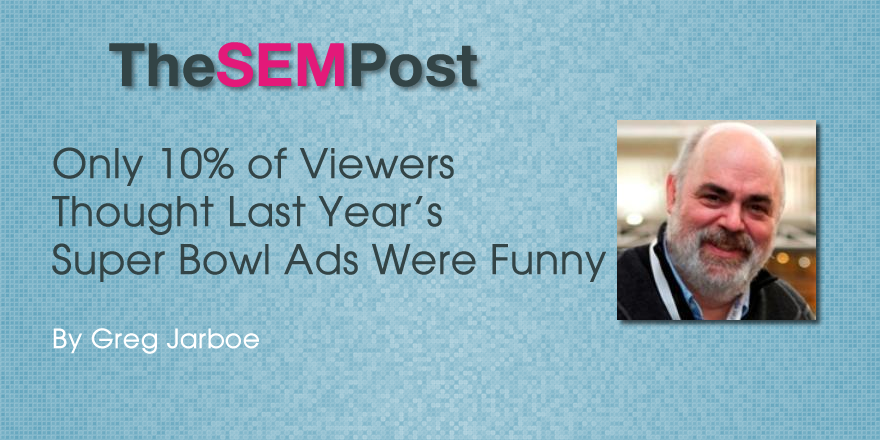
Online engagement with Super Bowl 50 ads dropped nearly 20% from the previous year, according to new data launched yesterday by video ad tech company Unruly. Unruly’s Science of Sharing: Super Bowl 50 study shows that shares of Super Bowl 2016 ads across social media fell from 9.03M in 2015 to 7.84M last year – a drop of 17%.
Unruly data reveals that the main reason for this decrease in online engagement is that Super Bowl 2016 ads failed to evoke intense emotional responses in viewers, a critical issue when intense emotional response is the key driver of video shares and engagement. Humor, in particular, was in short supply. Despite many advertisers attempting to make viewers laugh, only 10% of viewers felt the ads were actually funny. One exception was Doritos’ “Ultrasound,” which was the most shared ad of the Big Game, with 29% of viewers citing they found the video intensely funny.
It wasn’t just that ads failed to amuse. Viewer feelings of happiness, inspiration and amazement were also much lower than average, leading to the decline in overall viewer engagement with 2016 Super bowl ads. The results are in stark contrast to the record-breaking 2015 Super Bowl, when 80% of ads tested evoked intense emotional responses and delivered a wide range of emotional responses, including exhilaration and pride.
Additional findings from the Science of Sharing white paper reveal:
- Teaser ads made up nearly 30% of the total ads launched this Super Bowl, but only delivered 10% of overall views;
- The most successful ads were aired before the game, with 7 out of 10 of the most shared Super Bowl ads (excluding movie trailers) airing before Super Bowl Sunday;
- TV was the most common viewing device for viewing Super Bowl ads, followed by PC, while older Millennials and Gen X viewers were most likely to have seen the ad on a mobile device;
- Emotional responses differed by demo – 22% of the general population felt more negative about Mountain Dew after watching its controversial Super Bowl spot “#Puppymonkeybaby,” the 7th most shared ad from the game. In contrast, 58% of Millennial males felt more positive about the brand after watching the ad;
- Budweiser’s “#NotBackingDown” ad fell from the #1 spot in 2015 to #55 in 2016. Affectiva’s facial coding tracking shows its aggressive tone did not go down well with some viewers, who showed expressions of dislike throughout the video;
- The opportunity to amplify social sharing with a memorable soundtrack was wasted by many brands. Fewer than half of all ads used music, however, 70% of Super Bowl shares came from videos with prominent soundtracks.
Devra Prywes, Unruly’s SVP Insights and Marketing, US, said, “We’re looking to help advertisers make the most of the Super Bowl, the biggest stage of the year. The key things we share in the Science of Sharing: Super Bowl 50 report is that advertisers just didn’t create ads that packed an emotional punch with the audience. We track over 100 social variables, and generating a strong emotional response is the #1 thing advertisers can do to connect with their audiences and make people want to share them online, driving digital buzz. One problem is that many advertisers aimed for humor, but missed the mark (only 10% of viewers found the ads funny). Humor is just one of the 18 different psychological responses that we track. If advertisers want to stand out during the 2017 Big Game, we’d suggest relying on some of the lesser used responses – like pride, exhilaration, nostalgia or even sadness – to stand out from the crowd. We’ve seen this work well in the 2015 and 2013 Big Games which broke video sharing/engagement records!”
Prywes added, “Having a multi-platform distribution plan is the other key element in a strong Super Bowl plan. Content and distribution are two sides of the coin for success. Even the best ads have to be seen to earn engagement. And consumers are fragmented across many devices and platforms, so the key is to make your ad available and discoverable wherever people consume video content.”
Click here to download the full Science of Sharing report, along with emotional & brand analysis from Unruly EQ, facial coding analysis from Affectiva, and audio recommendations from Moodagent’s Listening Machine.
Methodology
The Science of Sharing: Super Bowl 50 study analyzed 33 official ads that aired during Super Bowl 2016. The study surveyed 16,500 panelists using Unruly’s algorithmic tool to determine the videos’ intrinsic shareability and impact on brand metrics. The study also used Affectiva’s facial coding and Moodagent’s Listening Machine. Results were aggregated into Unruly Pulse™ to determine Super Bowl Advertising Norms.
The report delivers content and distribution analysis, facial coding overview from Affectiva and analysis of intensity of the music throughout videos from Moodagent. It also includes recommendations on how to make Super Bowls more shareable online.
Greg Jarboe
Latest posts by Greg Jarboe (see all)
- Recreating Viral Video Success: Squatty Potty - October 20, 2017
- Baby Boomers are the Audience Most Advertisers are Missing on YouTube - September 19, 2017
- KnowledgeVision’s Knovio 3.0 is Not Your Old School Online Video Platform - June 30, 2017
- Top 10 Super Bowl Ads for 2017 Depend on Which Metrics You Use - February 7, 2017
- Only 10% of Viewers Thought Last Year’s Super Bowl Ads Were Funny - January 17, 2017
